How to Quantitatively Balance a Total Knee? A Surgical Algorithm to Assure Balance and Control Alignment
Abstract
1. Introduction
2. Materials and Methods
2.1. Clinical Data Collection
2.2. Surgical Corrections
- Arcuate release: Located in the posterolateral corner, the medial limb of the arcuate complex curves over the popliteus muscle to join with the oblique popliteal ligament, while the lateral limb ascends to blend with the capsule near the lateral gastrocnemius muscle (Figure 1). Both limbs of the arcuate complex were incised at the joint line with the knee in extension using curved scissors.
- Popliteus release: Located in the posterolateral corner, the popliteus connects the posterolateral femoral condyle to the popliteus muscle. During a release, this ligamentous structure is being resected with a 11- or 15-blade.
- Posterior capsule release: The attachment of the posterior capsule to the posterior distal femur was subperiosteally released using electrocautery and a Cobb elevator.ITB release: The iliotibial band (ITB) is located on the lateral side of the tibia was incised at the joint line using curved scissors.
2.3. Statistical Analysis
3. Results
3.1. Patient Population
3.2. Surgical Corrections
3.3. Effects on Alignment
3.4. Effects on Intra-Articular Loads
4. Discussion
5. Conclusions
Author Contributions
Funding
Institutional Review Board Statement
Informed Consent Statement
Data Availability Statement
Conflicts of Interest
References
- Leone, W.; Geller, J.; Chow, J.; Branovacki, G.; Do, J.M.; Meere, P. Using Sensors to Evaluate Revision TKA: Treating the “Looks Good; Feels Bad” Knee. EC Orthop. 2016, 5, 381–385. [Google Scholar]
- Gustke, K.A.; Golladay, G.J.; Roche, M.W.; Elson, L.C.; Anderson, C.R. A New Method for Defining Balance. J. Arthroplast. 2014, 29, 955–960. [Google Scholar] [CrossRef] [PubMed]
- Golladay, G.J.; Bradbury, T.L.; Gordon, A.C.; Fernandez-Madrid, I.J.; Krebs, V.E.; Patel, P.D.; Suarez, J.C.; Higuera, C.A.; Barsoum, W.K. Are Patients More Satisfied with a Balanced Total Knee Arthroplasty? J. Arthroplast. 2019, 34, S195–S200. [Google Scholar] [CrossRef] [PubMed]
- Geller, J.A.; Lakra, A.; Murtaugh, T. The Use of Electronic Sensor Device to Augment Ligament Balancing Leads to a Lower Rate of Arthrofibrosis after Total Knee Arthroplasty. J. Arthroplast. 2017, 32, 1502–1504. [Google Scholar] [CrossRef] [PubMed]
- Elmallah, R.K.; Mistry, J.B.; Cherian, J.J.; Chughtai, M.; Bhave, A.; Roche, M.W.; Mont, M.A. Can We Really “Feel” a Balanced Total Knee Arthroplasty? J. Arthroplast. 2016, 31, 102–105. [Google Scholar] [CrossRef] [PubMed]
- MacDessi, S.J.; Gharaibeh, M.A.; Harris, I.A. How Accurately Can Soft Tissue Balance Be Determined in Total Knee Arthroplasty? J. Arthroplast. 2019, 34, 290–294.e1. [Google Scholar] [CrossRef] [PubMed]
- Gharaibeh, M.A.; Chen, D.B.; MacDessi, S.J. Soft tissue balancing in total knee arthroplasty using sensor-guided assessment: Is there a learning curve?: Sensor assessment learning curve. ANZ J. Surg. 2018, 88, 497–501. [Google Scholar] [CrossRef] [PubMed]
- Lakra, A.; Sarpong, N.O.; Jennings, E.L.; Grosso, M.J.; Cooper, H.J.; Shah, R.P.; Geller, J.A. The Learning Curve by Operative Time for Soft Tissue Balancing in Total Knee Arthroplasty Using Electronic Sensor Technology. J. Arthroplast. 2019, 34, 483–487. [Google Scholar] [CrossRef] [PubMed]
- Ghirardelli, S.; Bala, A.; Peretti, G.; Antonini, G.; Indelli, P.F. Intraoperative Sensing Technology to Achieve Balance in Primary Total Knee Arthroplasty. JBJS Rev. 2019, 7, 6. [Google Scholar] [CrossRef] [PubMed]
- Cho, K.-J.; Seon, J.-K.; Jang, W.-Y.; Park, C.-G.; Song, E.-K. Objective quantification of ligament balancing using VERASENSE in measured resection and modified gap balance total knee arthroplasty. BMC Musculoskelet. Disord. 2018, 19, 266. [Google Scholar] [CrossRef] [PubMed]
- Risitano, S.; Karamian, B.; Indelli, P.F. Intraoperative load-sensing drives the level of constraint in primary total knee arthroplasty: Surgical technique and review of the literature. J. Clin. Orthop. Trauma 2017, 8, 265–269. [Google Scholar] [CrossRef] [PubMed]
- Walker, P.S.; Meere, P.A.; Bell, C.P. Effects of surgical variables in balancing of total knee replacements using an instrumented tibial trial. Knee 2014, 21, 156–161. [Google Scholar] [CrossRef] [PubMed]
- Gustke, K.A.; Golladay, G.J.; Roche, M.W.; Elson, L.C.; Anderson, C.R. A Targeted Approach to Ligament Balancing Using Kinetic Sensors. J. Arthroplast. 2017, 32, 2127–2132. [Google Scholar] [CrossRef] [PubMed]
- Meere, P.A.; Schneider, S.M.; Walker, P.S. Accuracy of Balancing at Total Knee Surgery Using an Instrumented Tibial Trial. J. Arthroplast. 2016, 31, 1938–1942. [Google Scholar] [CrossRef] [PubMed]
- Cochetti, A.; Ghirardelli, S.; Iannotti, F.; Giardini, P.; Risitano, S.; Indelli, P.F. Sensor-guided technology helps to reproduce medial pivot kinematics in total knee arthroplasty. J. Orthop. Surg. 2020, 28, 230949902096613. [Google Scholar] [CrossRef] [PubMed]
- Bellemans, J. Multiple Needle Puncturing: Balancing the Varus Knee. Orthopedics 2011. [Google Scholar] [CrossRef] [PubMed]
- Herschmiller, T.; Grosso, M.J.; Cunn, G.J.; Murtaugh, T.S.; Gardner, T.R.; Geller, J.A. Step-wise medial collateral ligament needle puncturing in extension leads to a safe and predictable reduction in medial compartment pressure during TKA. Knee Surg. Sports Traumatol. Arthrosc. 2018, 26, 1759–1766. [Google Scholar] [CrossRef] [PubMed]
- Luyckx, T.; Verstraete, M.; De Roo, K.; Van Der Straeten, C.; Victor, J. High strains near femoral insertion site of the superficial medial collateral ligament of the Knee can explain the clinical failure pattern: 3D deformation analysis of the sMCL. J. Orthop. Res. 2016, 34, 2016–2024. [Google Scholar] [CrossRef] [PubMed]
- Zapata, G.; Sanz-Pena, I.; Verstraete, M.; Walker, P.S. Effects of femoral component placement on the balancing of a total knee at surgery. J. Biomech. 2019, 86, 117–124. [Google Scholar] [CrossRef] [PubMed]
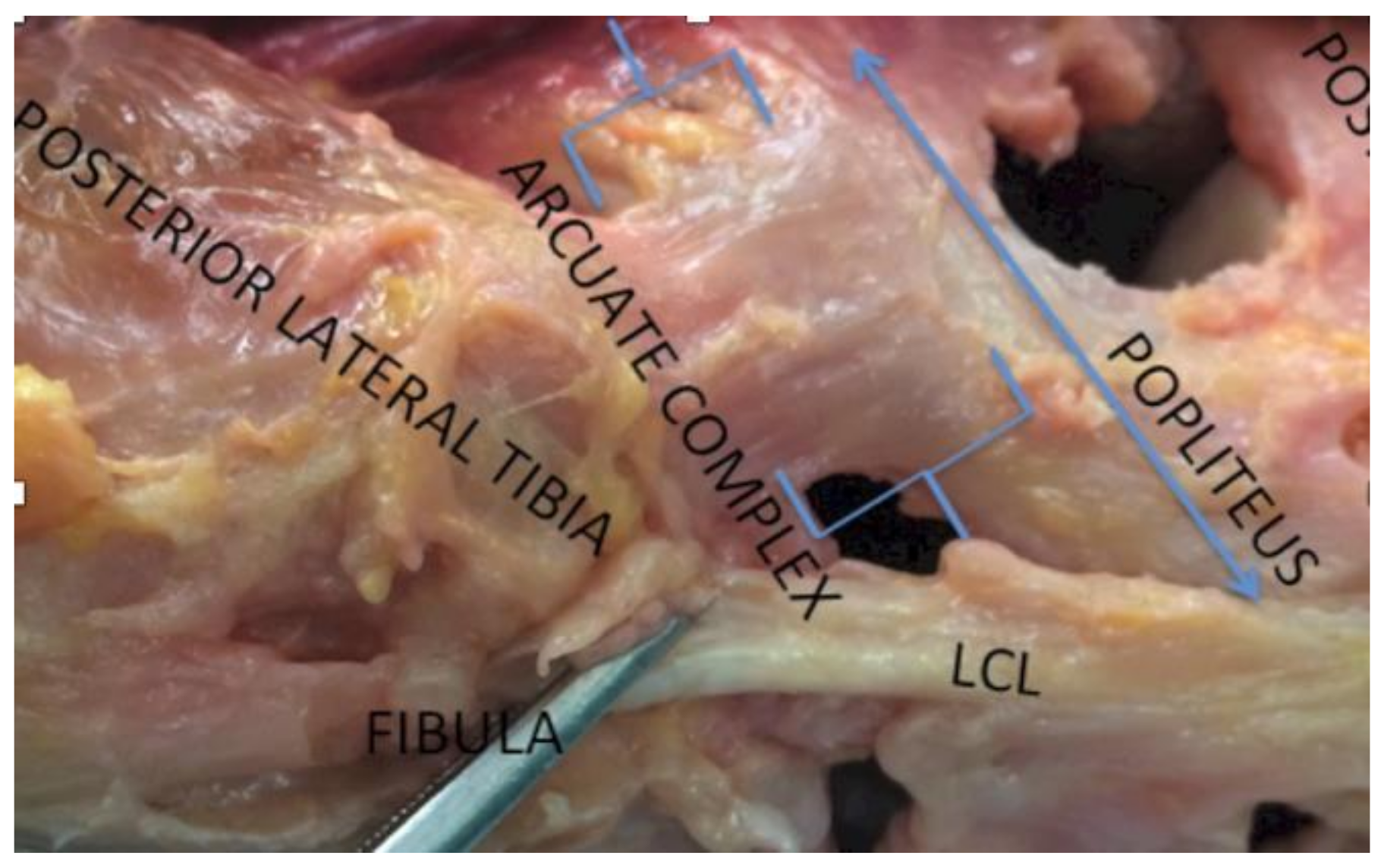
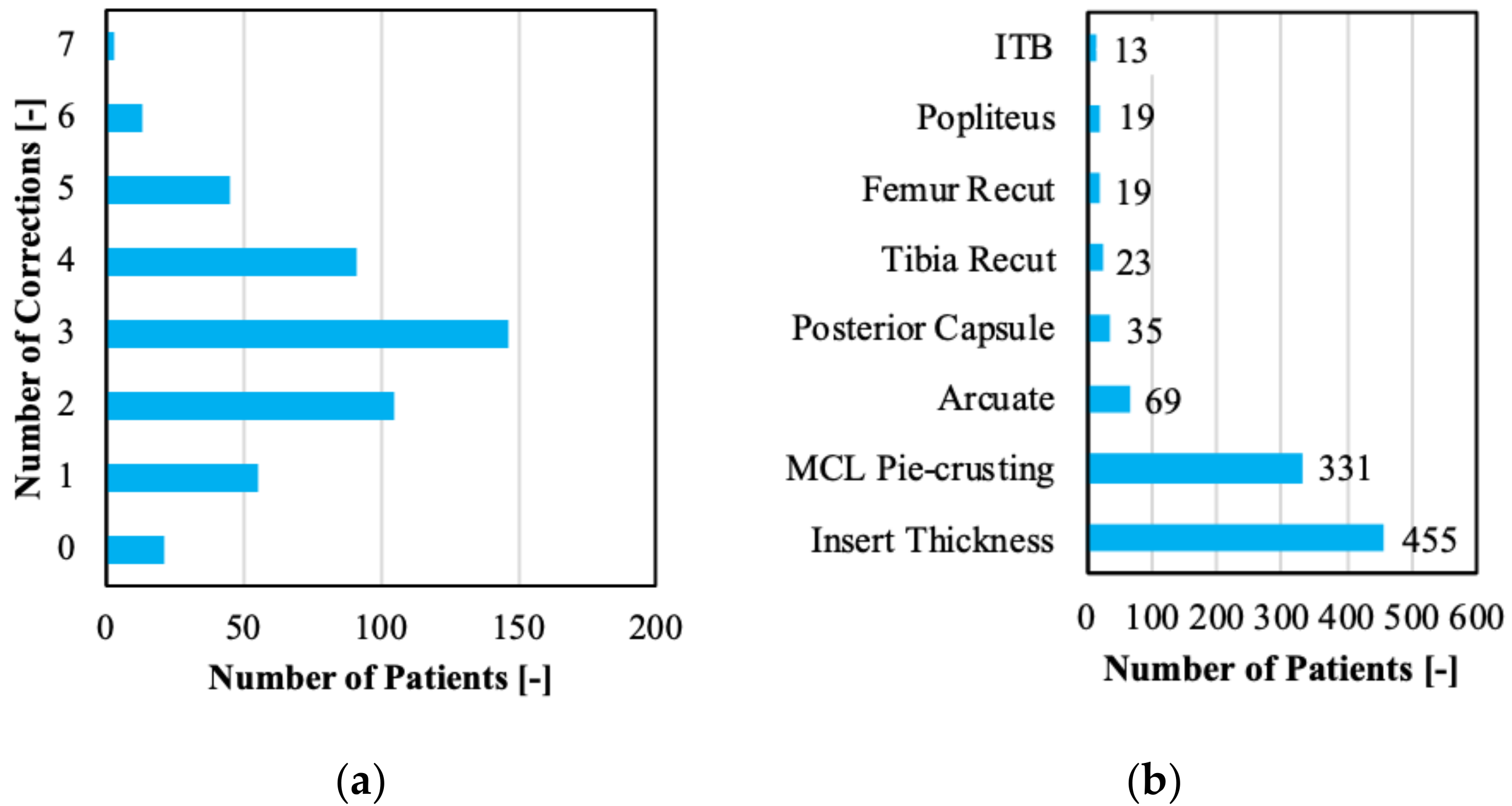
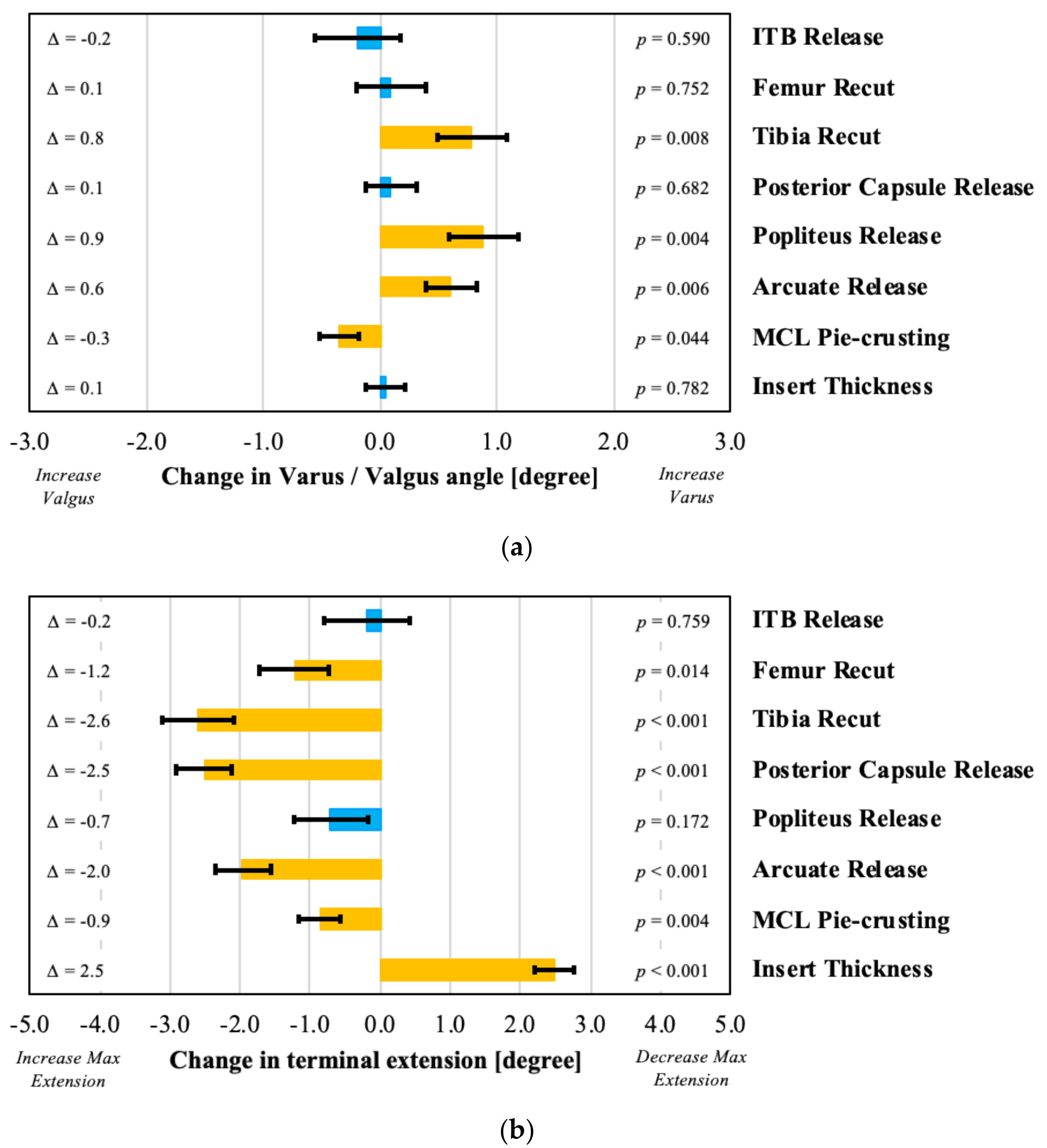
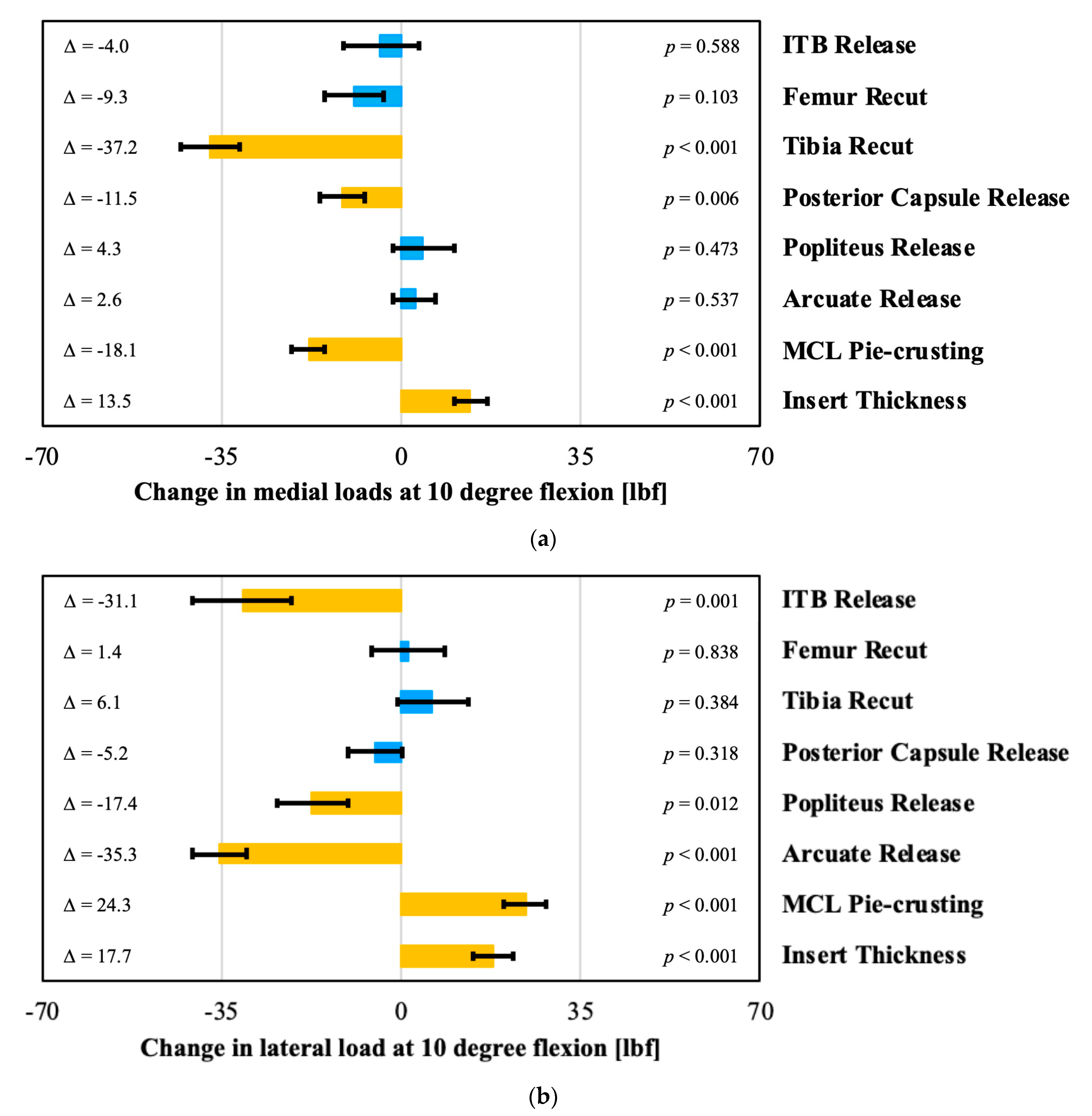
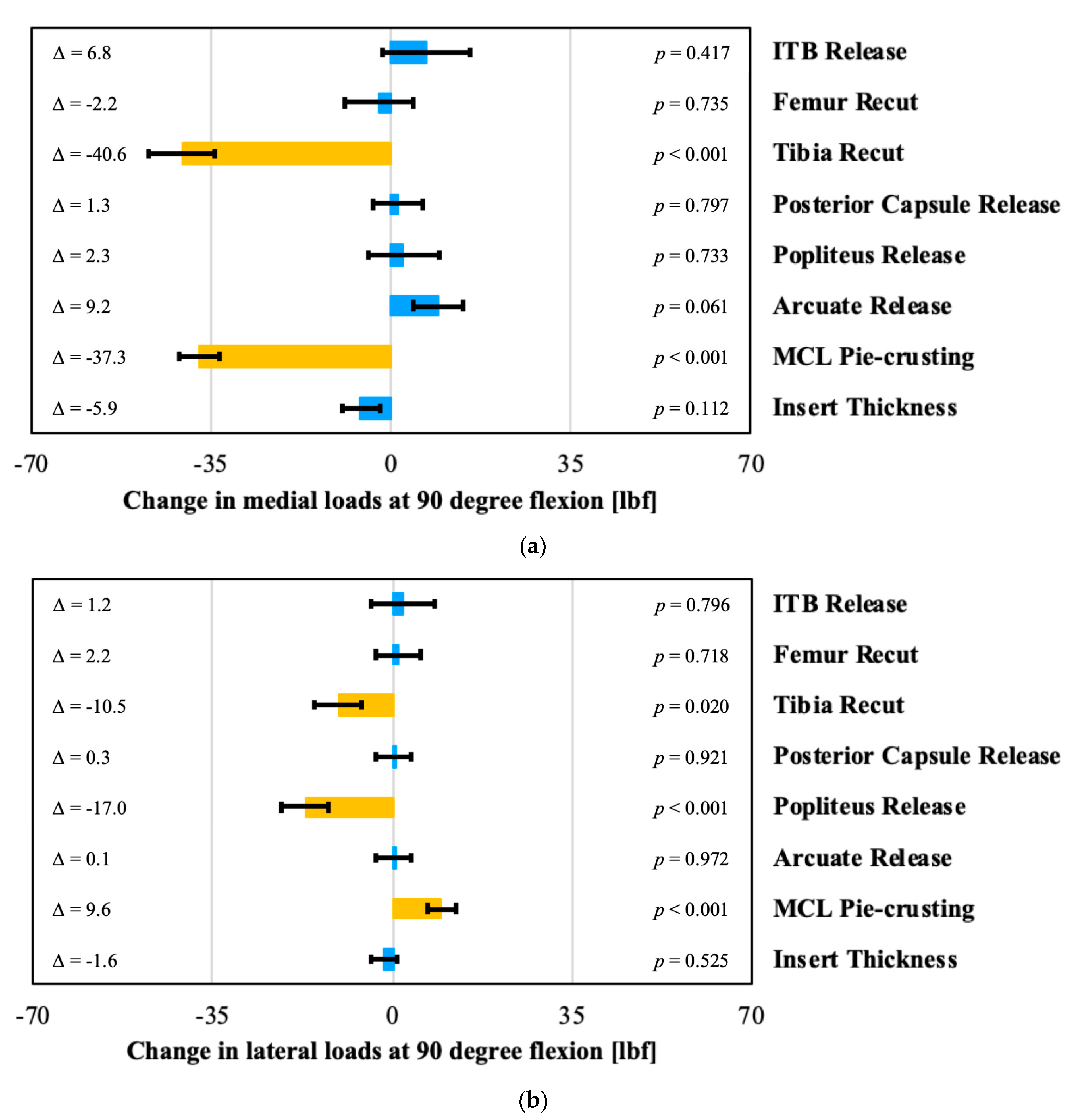
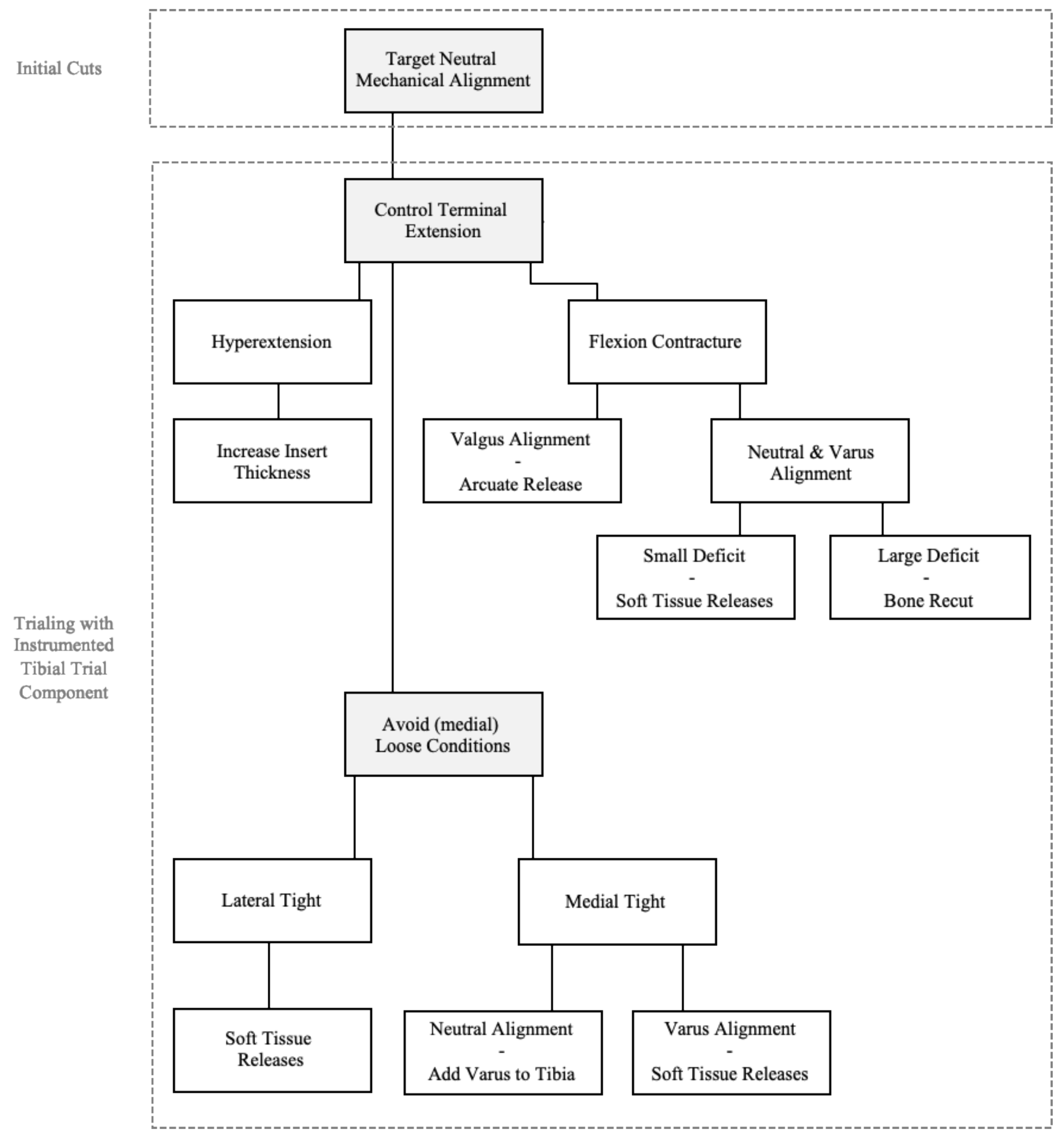
Publisher’s Note: MDPI stays neutral with regard to jurisdictional claims in published maps and institutional affiliations. |
© 2021 by the authors. Licensee MDPI, Basel, Switzerland. This article is an open access article distributed under the terms and conditions of the Creative Commons Attribution (CC BY) license (http://creativecommons.org/licenses/by/4.0/).
Share and Cite
Moore, R.E.; Conditt, M.A.; Roche, M.W.; Verstraete, M.A. How to Quantitatively Balance a Total Knee? A Surgical Algorithm to Assure Balance and Control Alignment. Sensors 2021, 21, 700. https://doi.org/10.3390/s21030700
Moore RE, Conditt MA, Roche MW, Verstraete MA. How to Quantitatively Balance a Total Knee? A Surgical Algorithm to Assure Balance and Control Alignment. Sensors. 2021; 21(3):700. https://doi.org/10.3390/s21030700
Chicago/Turabian StyleMoore, Ryan E., Michael A. Conditt, Martin W. Roche, and Matthias A. Verstraete. 2021. "How to Quantitatively Balance a Total Knee? A Surgical Algorithm to Assure Balance and Control Alignment" Sensors 21, no. 3: 700. https://doi.org/10.3390/s21030700
APA StyleMoore, R. E., Conditt, M. A., Roche, M. W., & Verstraete, M. A. (2021). How to Quantitatively Balance a Total Knee? A Surgical Algorithm to Assure Balance and Control Alignment. Sensors, 21(3), 700. https://doi.org/10.3390/s21030700




